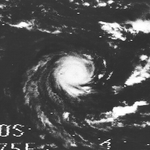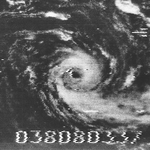| Revision as of 19:58, 17 May 2021 editColonies Chris (talk | contribs)Autopatrolled, Extended confirmed users, Pending changes reviewers, Rollbackers445,550 edits →References← Previous edit |
Revision as of 02:59, 16 April 2022 edit undoJason Rees (talk | contribs)Autopatrolled, Extended confirmed users, Pending changes reviewers, Rollbackers, Template editors89,518 editsNo edit summaryNext edit → |
| Line 166: |
Line 166: |
|
|1-min winds=75 |
|
|1-min winds=75 |
|
}} |
|
}} |
|
Cyclone Felicie was a slow moving cyclone that made a large number of landfalls in Madagascar, 4, in addition to a single landfall in Mozambique, which reportedly killed 30 people. The storm followed a very erratic track due to unusual steering patterns, and went through many cycles of strengthening and weakening as it slowly trudged to the south. Felicie reached Tropical Cyclone status three separate times, before finally becoming extratropical southwest of Madagascar.<ref>{{cite report|series=Global tropical/extratropical cyclone climatic atlas|title=Tropical Storm Felice, 17 January- 5 February|year=1996|work=National Climatic Data Center|access-date=February 11, 2019|url=http://webapp1.dlib.indiana.edu/virtual_disk_library/index.cgi/4274123/FID218/DATA/TROPIC/SWI_NAR/1971_2.NAR}}</ref> |
|
Cyclone Felicie was a slow moving cyclone that made a large number of landfalls in Madagascar, 4, in addition to a single landfall in Mozambique, which reportedly killed 30 people. The storm followed a very erratic track due to unusual steering patterns, and went through many cycles of strengthening and weakening as it slowly trudged to the south. Felicie reached Tropical Cyclone status three separate times, before finally becoming extratropical southwest of Madagascar.<ref>{{cite report|series=Global tropical/extratropical cyclone climatic atlas|title=Tropical Storm Felice, 17 January- 5 February|year=1996|work=National Climatic Data Center|access-date=February 11, 2019|url={{GTECCA url|basin=SWI|year=1971_2}}}}</ref> |
|
{{clear}} |
|
{{clear}} |
|
|
|
|
| Line 180: |
Line 180: |
|
|1-min winds=90 |
|
|1-min winds=90 |
|
}} |
|
}} |
|
On January 19, Severe Tropical Cyclone Myrtle entered the South-West Indian Ocean; therefore, it was assigned a second name, Ginette. The next day, Ginette reached hurricane status and developed a clear eye as it traveled generally west-southwestward. On January 22, Ginette curved southwestward and came within 72 kilometers (45 miles) of the island of Rodrigues. On Rodrigues, winds as high as 150 km/h (93 mph) were recorded along with a minimum barometric pressure of 989 mbar (29.21 inHg). Throughout the next two days, Ginette approached the island of Reunion, causing stormy weather that lasted until January 29. In Reunion, swells associated with Ginette reached 6 meters (20 feet) at times. On January 25, Ginette became stationary while located south of Reunion. The next day, Ginette encountered a ridge which caused it to execute a small clockwise loop. After completing the loop, Ginette accelerated southeastward and gradually weakened. By January 31, Ginette had transitioned into an extratropical cyclone.<ref>{{cite report|url=http://webapp1.dlib.indiana.edu/virtual_disk_library/index.cgi/4274123/FID218/DATA/TROPIC/SWI_NAR/1971_1.NAR|title=Hurricane Ginette, 17-31 January|access-date=February 12, 2019|series=Global tropical/extratropical cyclone climatic atlas|year=1996|work=National Climatic Data Center}}</ref> |
|
On January 19, Severe Tropical Cyclone Myrtle entered the South-West Indian Ocean; therefore, it was assigned a second name, Ginette. The next day, Ginette reached hurricane status and developed a clear eye as it traveled generally west-southwestward. On January 22, Ginette curved southwestward and came within 72 kilometers (45 miles) of the island of Rodrigues. On Rodrigues, winds as high as 150 km/h (93 mph) were recorded along with a minimum barometric pressure of 989 mbar (29.21 inHg). Throughout the next two days, Ginette approached the island of Reunion, causing stormy weather that lasted until January 29. In Reunion, swells associated with Ginette reached 6 meters (20 feet) at times. On January 25, Ginette became stationary while located south of Reunion. The next day, Ginette encountered a ridge which caused it to execute a small clockwise loop. After completing the loop, Ginette accelerated southeastward and gradually weakened. By January 31, Ginette had transitioned into an extratropical cyclone.<ref>{{cite report|url={{GTECCA url|basin=SWI|year=1971_1}}|title=Hurricane Ginette, 17-31 January|access-date=February 12, 2019|series=Global tropical/extratropical cyclone climatic atlas|year=1996|work=National Climatic Data Center}}</ref> |
|
{{clear}} |
|
{{clear}} |
|
|
|
|
| Line 194: |
Line 194: |
|
|1-min winds=90 |
|
|1-min winds=90 |
|
}} |
|
}} |
|
On February 8, Helga passed southeast of Réunion and Mauritius, bringing heavy rainfall to the former island, reaching {{convert|926|mm|in|abbr=on}} at Commerson. Two people died on the island due to drowning.<ref>{{cite report|series=Global tropical/extratropical cyclone climatic atlas|title=Hurricane Helga, 3-12 February|year=1996|work=National Climatic Data Center|access-date=February 11, 2019|url=http://webapp1.dlib.indiana.edu/virtual_disk_library/index.cgi/4274123/FID218/DATA/TROPIC/SWI_NAR/1971_4.NAR}}</ref> |
|
On February 8, Helga passed southeast of Réunion and Mauritius, bringing heavy rainfall to the former island, reaching {{convert|926|mm|in|abbr=on}} at Commerson. Two people died on the island due to drowning.<ref>{{cite report|series=Global tropical/extratropical cyclone climatic atlas|title=Hurricane Helga, 3-12 February|year=1996|work=National Climatic Data Center|access-date=February 11, 2019|url={{GTECCA url|basin=SWI|year=1971_4}}}}</ref> |
|
{{clear}} |
|
{{clear}} |
|
|
|
|
Cyclone Felicie was a slow moving cyclone that made a large number of landfalls in Madagascar, 4, in addition to a single landfall in Mozambique, which reportedly killed 30 people. The storm followed a very erratic track due to unusual steering patterns, and went through many cycles of strengthening and weakening as it slowly trudged to the south. Felicie reached Tropical Cyclone status three separate times, before finally becoming extratropical southwest of Madagascar.
On January 19, Severe Tropical Cyclone Myrtle entered the South-West Indian Ocean; therefore, it was assigned a second name, Ginette. The next day, Ginette reached hurricane status and developed a clear eye as it traveled generally west-southwestward. On January 22, Ginette curved southwestward and came within 72 kilometers (45 miles) of the island of Rodrigues. On Rodrigues, winds as high as 150 km/h (93 mph) were recorded along with a minimum barometric pressure of 989 mbar (29.21 inHg). Throughout the next two days, Ginette approached the island of Reunion, causing stormy weather that lasted until January 29. In Reunion, swells associated with Ginette reached 6 meters (20 feet) at times. On January 25, Ginette became stationary while located south of Reunion. The next day, Ginette encountered a ridge which caused it to execute a small clockwise loop. After completing the loop, Ginette accelerated southeastward and gradually weakened. By January 31, Ginette had transitioned into an extratropical cyclone.
On February 8, Helga passed southeast of Réunion and Mauritius, bringing heavy rainfall to the former island, reaching 926 mm (36.5 in) at Commerson. Two people died on the island due to drowning.
 Season summary map
Season summary map



























